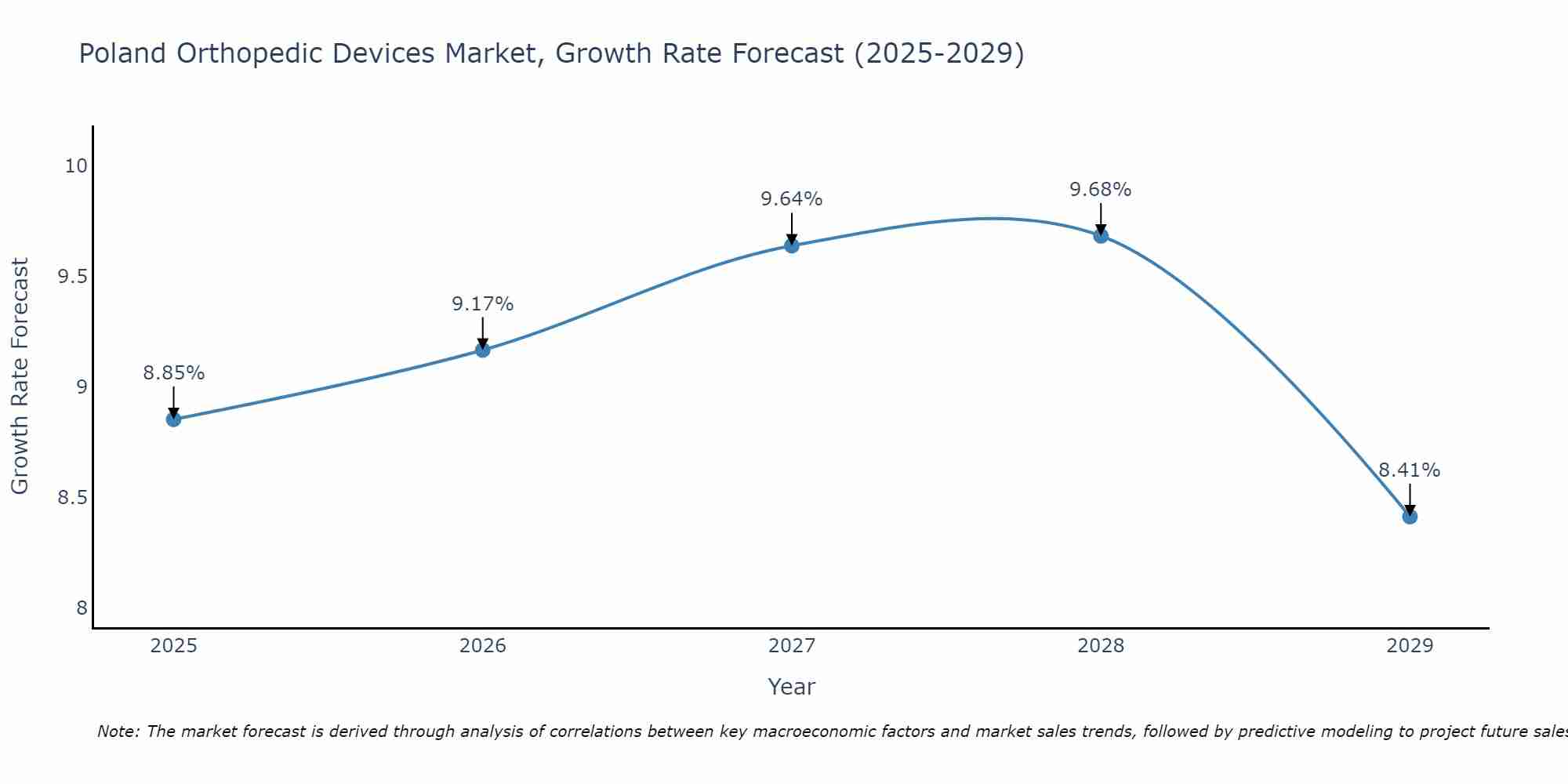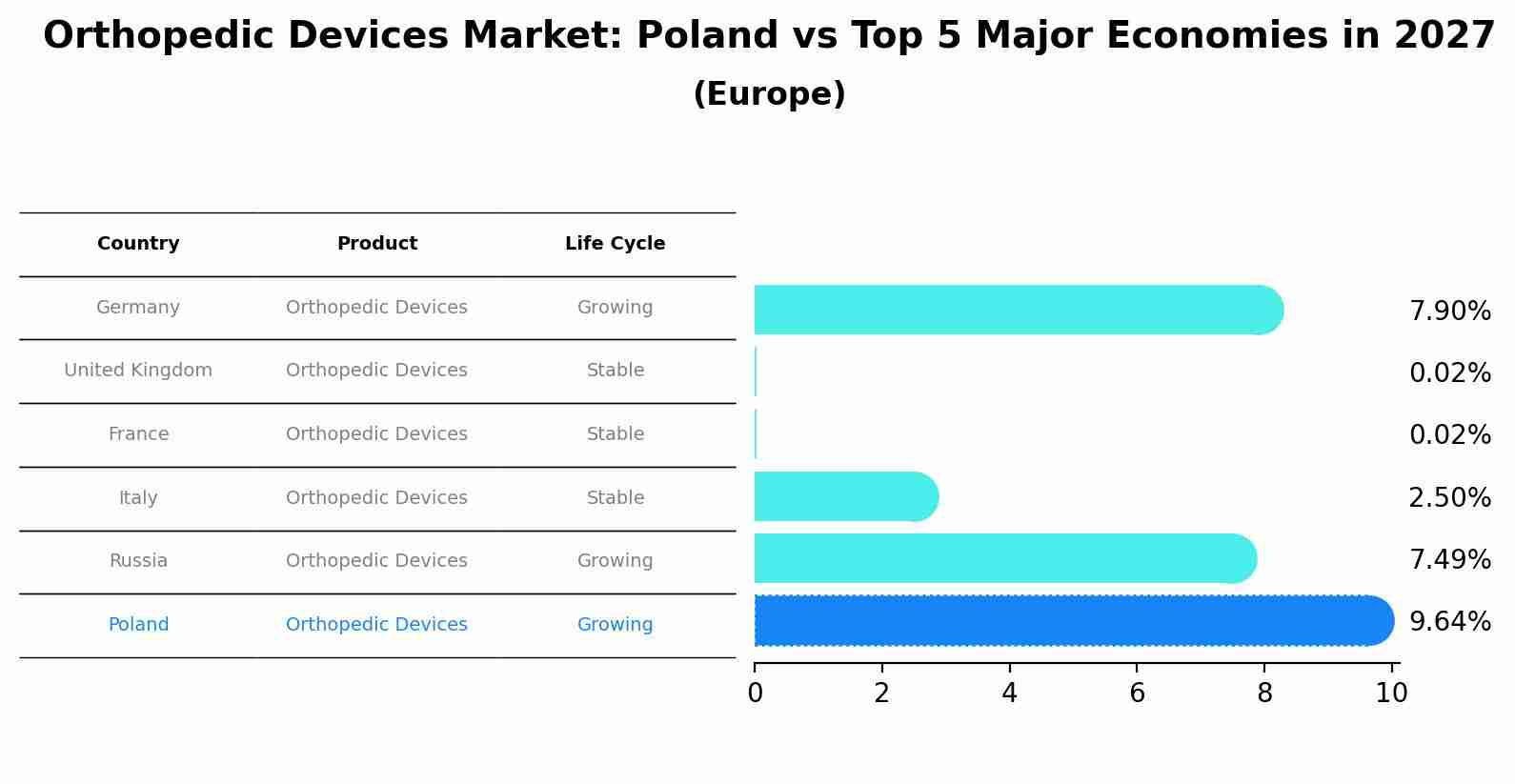Poland Orthopedic Devices Market (2025-2031) Outlook | Industry, Trends, Value, Forecast, Revenue, Growth, Companies, Analysis, Size & Share
| Product Code: ETC368115 | Publication Date: Aug 2022 | Updated Date: Jul 2025 | Product Type: Market Research Report | |
| Publisher: 6Wresearch | Author: Bhawna Singh | No. of Pages: 75 | No. of Figures: 35 | No. of Tables: 20 |
Poland Orthopedic Devices Market Size Growth Rate
The Poland Orthopedic Devices Market is projected to witness mixed growth rate patterns during 2025 to 2029. Growth accelerates to 9.68% in 2028, following an initial rate of 8.85%, before easing to 8.41% at the end of the period.

Orthopedic Devices Market: Poland vs Top 5 Major Economies in 2027 (Europe)
The Orthopedic Devices market in Poland is projected to grow at a growing growth rate of 9.64% by 2027, highlighting the country's increasing focus on advanced technologies within the Europe region, where Germany holds the dominant position, followed closely by United Kingdom, France, Italy and Russia, shaping overall regional demand.

Poland Orthopedic Devices Market Synopsis
The Poland Orthopedic Devices Market is experiencing steady growth due to factors such as an aging population, increasing prevalence of orthopedic disorders, and advancements in medical technology. The market is characterized by a wide range of products including joint reconstruction, spinal devices, trauma fixation, orthobiologics, and orthopedic accessories. Key players in the market are focusing on product innovation, strategic partnerships, and acquisitions to stay competitive. The demand for minimally invasive procedures and personalized orthopedic solutions is also driving market growth. Government initiatives to improve healthcare infrastructure and rising healthcare expenditure are further propelling the market. However, pricing pressures, regulatory challenges, and the impact of the COVID-19 pandemic are some of the factors that may hinder market growth in the short term.
Poland Orthopedic Devices Market Trends
In the Poland Orthopedic Devices Market, there are several key trends emerging. One significant trend is the increasing demand for minimally invasive orthopedic procedures and devices, driven by the growing aging population and rising prevalence of orthopedic conditions. Another trend is the adoption of advanced technologies such as 3D printing, robotics, and augmented reality in the development and customization of orthopedic implants and devices. Additionally, there is a focus on the development of innovative materials and designs to improve the durability, performance, and patient outcomes of orthopedic devices. Market players are also investing in research and development to introduce new products and solutions catering to the specific needs of patients, healthcare providers, and healthcare systems in Poland.
Poland Orthopedic Devices Market Challenges
In the Poland Orthopedic Devices Market, several challenges are faced, including increasing competition among market players, stringent regulatory requirements for product approval, and limited reimbursement policies for orthopedic procedures. Additionally, the rising cost of orthopedic devices and the need for advanced technology investments pose significant challenges for market growth. Furthermore, the aging population and the prevalence of orthopedic disorders are driving the demand for orthopedic devices, but the market also faces issues related to the adoption of innovative technologies and the lack of skilled healthcare professionals specialized in orthopedic care. Overall, navigating these challenges requires strategic planning, product differentiation, compliance with regulations, and a deep understanding of market trends to sustain growth in the Poland Orthopedic Devices Market.
Poland Orthopedic Devices Market Investment Opportunities
The Poland Orthopedic Devices Market presents various investment opportunities, including the growing demand for advanced orthopedic implants and devices due to the increasing prevalence of musculoskeletal disorders and an aging population. Investors can explore opportunities in the development and distribution of innovative orthopedic technologies such as 3D-printed implants, robotic-assisted surgical devices, and minimally invasive surgical instruments. Additionally, partnerships with local healthcare providers and research institutions can facilitate market entry and expansion. With the healthcare sector in Poland experiencing continuous growth and government initiatives to improve healthcare infrastructure, investing in the orthopedic devices market can be a promising venture for those looking to capitalize on the country`s evolving healthcare landscape.
Jordan Agar Market Government Policies
In Poland, the Orthopedic Devices Market is regulated by the Office for Registration of Medicinal Products, Medical Devices and Biocidal Products (URPL), which oversees the registration, marketing, and monitoring of orthopedic devices to ensure their safety and efficacy. The Polish government has implemented regulations and standards in alignment with the European Union Medical Devices Regulation (MDR) to enhance the quality and safety of orthopedic devices available in the market. Additionally, reimbursement policies by the National Health Fund (NFZ) play a significant role in determining the accessibility of orthopedic devices to patients in Poland. Manufacturers and distributors operating in the Poland Orthopedic Devices Market need to comply with these government policies to enter and sustain their presence in the market.
Poland Orthopedic Devices Market Future Outlook
The Poland Orthopedic Devices Market is poised for significant growth in the coming years due to factors such as an aging population, increasing prevalence of chronic diseases like osteoarthritis, and rising awareness about advanced orthopedic treatment options. The market is expected to benefit from technological advancements in orthopedic devices, leading to the development of innovative solutions for improved patient outcomes. Additionally, the growing emphasis on minimally invasive procedures and the expanding healthcare infrastructure in Poland are likely to drive market expansion. However, challenges such as pricing pressure and regulatory hurdles may impact market growth to some extent. Overall, the Poland Orthopedic Devices Market is projected to experience steady growth as demand for orthopedic procedures and devices continues to rise.
Key Highlights of the Report:
- Poland Orthopedic Devices Market Outlook
- Market Size of Poland Orthopedic Devices Market, 2024
- Forecast of Poland Orthopedic Devices Market, 2031
- Historical Data and Forecast of Poland Orthopedic Devices Revenues & Volume for the Period 2021 - 2031
- Poland Orthopedic Devices Market Trend Evolution
- Poland Orthopedic Devices Market Drivers and Challenges
- Poland Orthopedic Devices Price Trends
- Poland Orthopedic Devices Porter's Five Forces
- Poland Orthopedic Devices Industry Life Cycle
- Historical Data and Forecast of Poland Orthopedic Devices Market Revenues & Volume By Application for the Period 2021 - 2031
- Historical Data and Forecast of Poland Orthopedic Devices Market Revenues & Volume By Hip Orthopedic Devices for the Period 2021 - 2031
- Historical Data and Forecast of Poland Orthopedic Devices Market Revenues & Volume By Knee Orthopedic Devices for the Period 2021 - 2031
- Historical Data and Forecast of Poland Orthopedic Devices Market Revenues & Volume By Spine Orthopedic Devices for the Period 2021 - 2031
- Historical Data and Forecast of Poland Orthopedic Devices Market Revenues & Volume By Craniomaxillofacial Orthopedic Devices for the Period 2021 - 2031
- Historical Data and Forecast of Poland Orthopedic Devices Market Revenues & Volume By Dental Orthopedic Devices for the Period 2021 - 2031
- Historical Data and Forecast of Poland Orthopedic Devices Market Revenues & Volume By Sports Injuries, Extremities And Trauma (Set) Orthopedic Devices for the Period 2021 - 2031
- Historical Data and Forecast of Poland Orthopedic Devices Market Revenues & Volume By Product for the Period 2021 - 2031
- Historical Data and Forecast of Poland Orthopedic Devices Market Revenues & Volume By Drill Guide for the Period 2021 - 2031
- Historical Data and Forecast of Poland Orthopedic Devices Market Revenues & Volume By Guide Tubes for the Period 2021 - 2031
- Historical Data and Forecast of Poland Orthopedic Devices Market Revenues & Volume By Implant Holder for the Period 2021 - 2031
- Historical Data and Forecast of Poland Orthopedic Devices Market Revenues & Volume By Custom Clamps for the Period 2021 - 2031
- Historical Data and Forecast of Poland Orthopedic Devices Market Revenues & Volume By Distracters for the Period 2021 - 2031
- Historical Data and Forecast of Poland Orthopedic Devices Market Revenues & Volume By Screw Drivers for the Period 2021 - 2031
- Historical Data and Forecast of Poland Orthopedic Devices Market Revenues & Volume By Accessories for the Period 2021 - 2031
- Poland Orthopedic Devices Import Export Trade Statistics
- Market Opportunity Assessment By Application
- Market Opportunity Assessment By Product
- Poland Orthopedic Devices Top Companies Market Share
- Poland Orthopedic Devices Competitive Benchmarking By Technical and Operational Parameters
- Poland Orthopedic Devices Company Profiles
- Poland Orthopedic Devices Key Strategic Recommendations
Frequently Asked Questions About the Market Study (FAQs):
- Single User License$ 1,995
- Department License$ 2,400
- Site License$ 3,120
- Global License$ 3,795
Search
Related Reports
- Vietnam System Integrator Market (2025-2031) | Size, Companies, Analysis, Industry, Value, Forecast, Growth, Trends, Revenue & Share
- ASEAN and Thailand Brain Health Supplements Market (2025-2031) | Strategy, Consumer Insights, Analysis, Investment Trends, Opportunities, Growth, Size, Share, Industry, Revenue, Segments, Value, Segmentation, Supply, Forecast, Restraints, Outlook, Competition, Drivers, Trends, Demand, Pricing Analysis, Competitive, Strategic Insights, Companies, Challenges
- ASEAN Bearings Market (2025-2031) | Strategy, Consumer Insights, Analysis, Investment Trends, Opportunities, Growth, Size, Share, Industry, Revenue, Segments, Value, Segmentation, Supply, Forecast, Restraints, Outlook, Competition, Drivers, Trends, Demand, Pricing Analysis, Competitive, Strategic Insights, Companies, Challenges
- Europe Flooring Market (2025-2031) | Outlook, Share, Industry, Trends, Forecast, Companies, Revenue, Size, Analysis, Growth & Value
- Saudi Arabia Manlift Market (2025-2031) | Outlook, Size, Growth, Trends, Companies, Industry, Revenue, Value, Share, Forecast & Analysis
- Uganda Excavator, Crane, and Wheel Loaders Market (2025-2031) | Strategy, Consumer Insights, Analysis, Investment Trends, Opportunities, Growth, Size, Share, Industry, Revenue, Segments, Value, Segmentation, Supply, Forecast, Restraints, Outlook, Competition, Drivers, Trends, Demand, Pricing Analysis, Competitive, Strategic Insights, Companies, Challenges
- Rwanda Excavator, Crane, and Wheel Loaders Market (2025-2031) | Strategy, Consumer Insights, Analysis, Investment Trends, Opportunities, Growth, Size, Share, Industry, Revenue, Segments, Value, Segmentation, Supply, Forecast, Restraints, Outlook, Competition, Drivers, Trends, Demand, Pricing Analysis, Competitive, Strategic Insights, Companies, Challenges
- Kenya Excavator, Crane, and Wheel Loaders Market (2025-2031) | Strategy, Consumer Insights, Analysis, Investment Trends, Opportunities, Growth, Size, Share, Industry, Revenue, Segments, Value, Segmentation, Supply, Forecast, Restraints, Outlook, Competition, Drivers, Trends, Demand, Pricing Analysis, Competitive, Strategic Insights, Companies, Challenges
- Angola Excavator, Crane, and Wheel Loaders Market (2025-2031) | Strategy, Consumer Insights, Analysis, Investment Trends, Opportunities, Growth, Size, Share, Industry, Revenue, Segments, Value, Segmentation, Supply, Forecast, Restraints, Outlook, Competition, Drivers, Trends, Demand, Pricing Analysis, Competitive, Strategic Insights, Companies, Challenges
- Israel Intelligent Transport System Market (2025-2031) | Strategy, Consumer Insights, Analysis, Investment Trends, Opportunities, Growth, Size, Share, Industry, Revenue, Segments, Value, Segmentation, Supply, Forecast, Restraints, Outlook, Competition, Drivers, Trends, Demand, Pricing Analysis, Competitive, Strategic Insights, Companies, Challenges
Industry Events and Analyst Meet
Our Clients
Whitepaper
- Middle East & Africa Commercial Security Market Click here to view more.
- Middle East & Africa Fire Safety Systems & Equipment Market Click here to view more.
- GCC Drone Market Click here to view more.
- Middle East Lighting Fixture Market Click here to view more.
- GCC Physical & Perimeter Security Market Click here to view more.
6WResearch In News
- Doha a strategic location for EV manufacturing hub: IPA Qatar
- Demand for luxury TVs surging in the GCC, says Samsung
- Empowering Growth: The Thriving Journey of Bangladesh’s Cable Industry
- Demand for luxury TVs surging in the GCC, says Samsung
- Video call with a traditional healer? Once unthinkable, it’s now common in South Africa
- Intelligent Buildings To Smooth GCC’s Path To Net Zero













